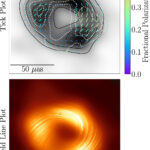2024-03-27 アリゾナ大学
<関連情報>
- https://news.arizona.edu/story/webb-telescope-takes-its-first-images-forming-planetary-systems
- https://iopscience.iop.org/article/10.3847/1538-3881/ad11d5
- https://iopscience.iop.org/article/10.3847/1538-3881/ad1ffc
- https://iopscience.iop.org/article/10.3847/1538-3881/ad2de9
JWST/NIRCamによる若い恒星天体の撮像。I.MWC758周辺の渦巻き円盤の外側にある惑星に関する制約 JWST/NIRCam Imaging of Young Stellar Objects. I. Constraints on Planets Exterior to the Spiral Disk Around MWC 758
Kevin Wagner, Jarron Leisenring, Gabriele Cugno, Camryn Mullin, Ruobing Dong, Schuyler G. Wolff, Thomas Greene, Doug Johnstone, Michael R. Meyer, Charles Beichman,+
The Astrophysical Journal Published:2024 March 27
DOI:10.3847/1538-3881/ad11d5

Abstract
MWC 758 is a young star hosting a spiral protoplanetary disk. The spirals are likely companion-driven, and two previously identified candidate companions have been identified—one at the end the Southern spiral arm at ∼0 6, and one interior to the gap at ∼0
6, and one interior to the gap at ∼0 1. With JWST/NIRCam, we provide new images of the disk and constraints on planets exterior to ∼1”. We detect the two-armed spiral disk, a known background star, and a spatially resolved background galaxy, but no clear companions. The candidates that have been reported are at separations that are not probed by our data with sensitivity sufficient to detect them−nevertheless, these observations place new limits on companions down to ∼2 MJup at ∼150 au and ∼0.5 MJup at ≳600 au. Owing to the unprecedented sensitivity of JWST and youth of the target, these are among the deepest mass-detection limits yet obtained through direct imaging observations, and provide new insights into the system’s dynamical nature.
1. With JWST/NIRCam, we provide new images of the disk and constraints on planets exterior to ∼1”. We detect the two-armed spiral disk, a known background star, and a spatially resolved background galaxy, but no clear companions. The candidates that have been reported are at separations that are not probed by our data with sensitivity sufficient to detect them−nevertheless, these observations place new limits on companions down to ∼2 MJup at ∼150 au and ∼0.5 MJup at ≳600 au. Owing to the unprecedented sensitivity of JWST and youth of the target, these are among the deepest mass-detection limits yet obtained through direct imaging observations, and provide new insights into the system’s dynamical nature.
JWST/NIRCamによる若い恒星天体の撮像。II. SAO 206462周辺の渦巻き円盤の外側にある巨大惑星と惑星候補に関する深い制約 JWST/NIRCam Imaging of Young Stellar Objects. II. Deep Constraints on Giant Planets and a Planet Candidate Outside of the Spiral Disk Around SAO 206462
Gabriele Cugno, Jarron Leisenring, Kevin R. Wagner, Camryn Mullin, Roubing Dong, Thomas Greene, Doug Johnstone, Michael R. Meyer, Schuyler G. Wolff, Charles Beichman,+
The Astrophysical Journal Published:2024 March 27
DOI:10.3847/1538-3881/ad1ffc

Abstract
We present JWST/NIRCam F187N, F200W, F405N, and F410M direct imaging data of the disk surrounding SAO 206462. Previous images show a very structured disk, with a pair of spiral arms thought to be launched by one or more external perturbers. The spiral features are visible in three of the four filters, with the nondetection in F410M due to the large detector saturation radius. We detect with a signal-to-noise ratio of 4.4 a companion candidate that, if on a coplanar circular orbit, would orbit SAO 206462 at a separation of ∼300 au, 2.25σ away from the predicted separation for the driver of the eastern spiral. No other companion candidates were detected. At the location predicted by simulations of both spirals generated by a single massive companion, the NIRCam data exclude objects more massive than ∼2.2 MJ assuming the BEX evolutionary models. In terms of temperatures, the data are sensitive to objects with Teff ∼ 650–850 K, when assuming planets emit like blackbodies (Rp between 1 and 3RJ). From these results, we conclude that if the spirals are driven by gas giants, these must be either cold or embedded in circumplanetary material. In addition, the NIRCam data provide tight constraints on ongoing accretion processes. In the low extinction scenario we are sensitive to mass accretion rates of the orderM˙∼10−9MJ yr−1. Thanks to the longer wavelengths used to search for emission lines, we reach unprecedented sensitivities to processes with M˙∼10−7MJ yr−1 even toward highly extincted environments (AV ≈ 50 mag).
JWST/NIRCamによる若い恒星天体の撮像。III. HLタウ円盤周辺の星雲環境の詳細な撮像 JWST/NIRCam Imaging of Young Stellar Objects. III. Detailed Imaging of the Nebular Environment around the HL Tau Disk
Camryn Mullin, Ruobing Dong, Jarron Leisenring, Gabriele Cugno, Thomas Greene, Doug Johnstone, Michael R. Meyer, Kevin R. Wagner, Schuyler G. Wolff, Martha Boyer,+
The Astrophysical Journal Published:2024 March 27
DOI:10.3847/1538-3881/ad2de9

Abstract
As part of the James Webb Space Telescope (JWST) Guaranteed Time Observation program “Direct Imaging of YSOs” (program ID 1179), we use JWST NIRCam’s direct imaging mode in F187N, F200W, F405N, and F410M to perform high-contrast observations of the circumstellar structures surrounding the protostar HL Tau. The data reveal the known stellar envelope, outflow cavity, and streamers, but do not detect any companion candidates. We detect scattered light from an inflowing spiral streamer previously detected in HCO+ by the Atacama Large Millimeter/submillimeter Array, and part of the structure connected to the c-shaped outflow cavity. For detection limits in planet mass we use BEX evolutionary tracks when Mp < 2 MJ and AMES-COND evolutionary tracks otherwise, assuming a planet age of 1 Myr (youngest available age). Inside the disk region, due to extended envelope emission, our point-source sensitivities are ∼5 mJy (37 MJ) at 40 au in F187N and ∼0.37 mJy (5.2 MJ) at 140 au in F405N. Outside the disk region, the deepest limits we can reach are ∼0.01 mJy (0.75 MJ) at a projected separation ∼ 525 au.



